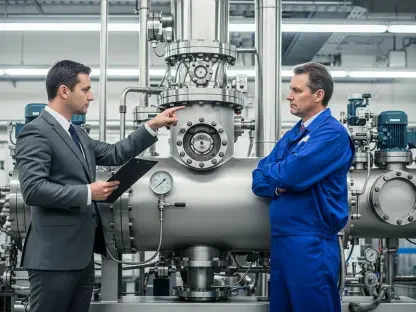The insurance industry stands at the crossroads of a significant evolution driven by technological advancements and the enduring preference for human interaction in customer service and claims adjusting. One of the main challenges faced by insurance companies is striking the right balance between AI-driven efficiency and the irreplaceable human touch that policyholders value. As AI technology continues to permeate various sectors, the insurance industry must navigate these changes while maintaining a high level of personalized service.
Douglas Weisskopf, client company manager at The Hartford Steam Boiler (HSB), articulates the importance of personal interaction in claims adjusting despite the increasing prevalence of automation. He notes that some clients prioritize the rapid resolutions facilitated by technology, while others value the hands-on approach of having a licensed adjuster physically assess the situation. This preference for human interaction signifies a broader industry trend in which policyholders seek a deeper connection with the claims and underwriting process, often diluted by excessive reliance on automated systems.
Weisskopf emphasizes that his company prioritizes direct contact, ensuring clients can reach dedicated claims professionals through various channels, thus upholding a customer-first model. This approach highlights the significance of effective communication and personalized service in building strong, lasting business relationships. Despite these strong preferences for human touch, the integration of AI in operational tasks cannot be ignored. AI’s current role in HSB is predominantly focused on handling mundane, repetitive tasks like internal communications, meeting summaries, email formatting, and translating policy documents. However, when it comes to complex decisions, especially in claims adjusting, the human element remains crucial.
The Role of AI in Operational Efficiency
In the realm of operational efficiency, AI has started to play a significant role by streamlining various routine tasks within the insurance sector. It processes large volumes of data quickly and accurately, thereby enhancing overall productivity. For example, HSB leverages AI to manage internal communications, meeting records, and even formatting emails, tasks that traditionally required significant human effort. This not only reduces the risk of errors but also frees up human resources for more critical, decision-making roles.
Moreover, AI’s ability to translate policy documents into various languages extends its utility beyond mere automation. This aspect is particularly beneficial in a globalized market, where clear communication across different languages is vital. Automated translation ensures that policyholders in diverse regions understand their coverage comprehensively, fostering a sense of trust and transparency. As AI systems become more sophisticated, their potential to handle more intricate tasks in underwriting is also anticipated. Yet, it is widely acknowledged within the industry that AI is best seen as a complement to human expertise rather than a replacement.
This collaborative future where AI supports but does not supplant human input ensures that complex, nuanced decisions remain the purview of experienced professionals. Moreover, policyholders benefit from quicker, more accurate service without sacrificing the personal interaction they value. This symbiotic relationship between human expertise and AI-driven efficiency marks a significant evolution in the insurance sector’s operational landscape.
The Importance of Human Interaction in Insurance
While AI significantly enhances operational efficiency, the human touch remains indispensable in the insurance industry, especially in client-facing roles. Douglas Weisskopf underscores that a hands-on approach in claims adjusting—where a licensed adjuster physically inspects the damages—often fulfills clients’ expectations better than an entirely automated assessment. This desire for personal interaction reflects a larger trend within the sector, where policyholders value direct connection and transparency in their dealings with insurance providers.
Clients who experience a personalized service are more likely to develop loyalty toward the provider, which is crucial for customer retention in a competitive market. This is particularly evident in complex or high-stress situations, such as when filing a claim after a significant loss. Personal interactions can offer reassurance, empathy, and tailored solutions that an automated system might fail to provide. Insurance companies recognize this need for balance and, therefore, strive to integrate technological advancements without compromising on the quality of human interactions.
By ensuring accessibility to dedicated claims professionals through various communication channels, firms like HSB place a strong emphasis on a customer-first model that builds lasting, trust-based relationships. While technology continues to evolve, the industry’s commitment to maintaining a human element ensures that client relationships and personalized service remain at the forefront of their operations.
Future Implications for AI and Human Collaboration
Looking ahead, the potential for AI to take on a more significant role in the insurance sector, particularly in underwriting, is undeniable. However, this development is envisaged as a partnership rather than a replacement strategy. The future of AI in insurance is centered around supporting and enhancing human expertise, ensuring that the nuanced decision-making processes continue to involve experienced professionals. This approach promises to retain the original integrity of personalized service while benefiting from the augmented efficiency and precision offered by AI.
As AI technology advances, its role is likely to expand into more complex fields, providing innovative solutions while human professionals focus on areas that require their judgment and emotional intelligence. The goal is not to eliminate human roles but to refine and elevate them, making the insurance process more efficient without losing the personal touch that clients value so deeply. This delicate balance between AI-driven efficiency and human interaction exemplifies the insurance industry’s adaptive strategy in an era of rapid technological advancement.
Striking the Perfect Balance
The insurance industry is at a pivotal point, driven by technological advancements and the enduring demand for human interaction in customer service and claims adjusting. Insurance companies face the challenge of balancing AI-driven efficiency with the human touch that policyholders value. As AI technology infiltrates various sectors, the industry must adapt while ensuring personalized service remains intact.
Douglas Weisskopf, a client company manager at The Hartford Steam Boiler (HSB), highlights the importance of personal interaction in the claims process despite growing automation. He points out that while some clients prefer the swift resolutions provided by technology, others value a licensed adjuster’s hands-on assessment. This preference for human interaction reflects a broader industry trend where policyholders desire a deeper connection with the claims and underwriting process, which can be diluted by excessive automation.
Weisskopf stresses that his company prioritizes direct contact, allowing clients to reach dedicated claims professionals through various channels, thereby maintaining a customer-first model. Effective communication and personalized service are essential for building strong, lasting business relationships. Despite the preference for human interaction, integrating AI in routine tasks cannot be overlooked. At HSB, AI primarily handles mundane tasks like internal communications, meeting summaries, email formatting, and translating policy documents. However, for complex decisions in claims adjusting, the human element remains irreplaceable.









